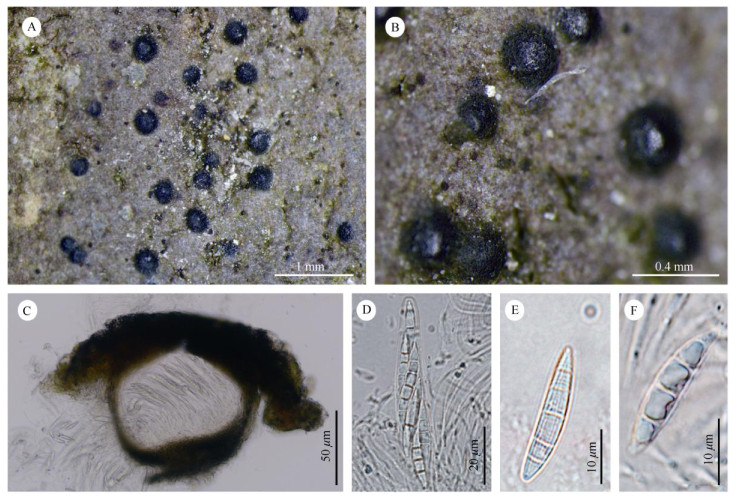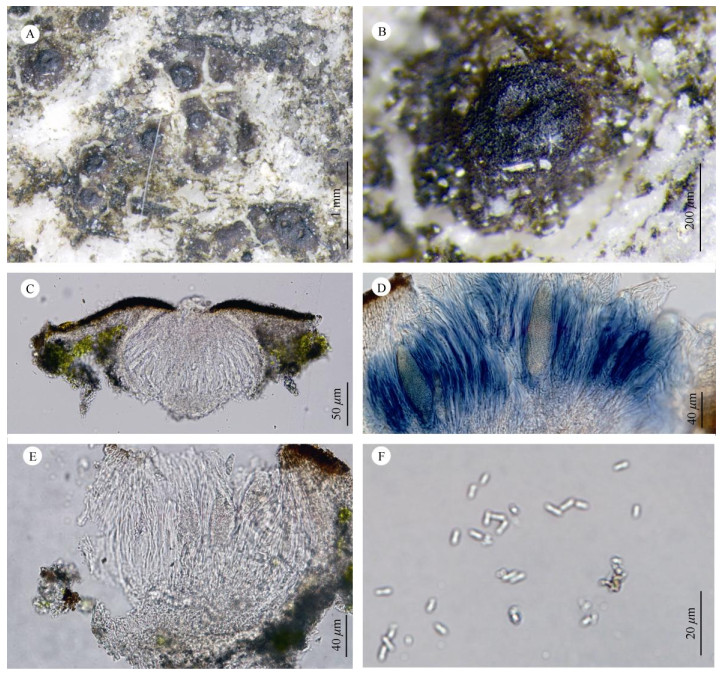Mt. Kunyu is a group of scenic mountains in Shandong Peninsula, with warm temperate monsoon climate. The highest point is Taibo Peak, at a height of 923 meters above sea level. Due to a variety of comprehensive factors such as topography and climate, Mt. Kunyu is rich in vegetation resources as well as lichen species[1].
Since the 1970s, some experts have come to Mt. Kunyu for research, but paid less attention to lichens. Only thirteen species belonging to 10 genera and 7 families were reported from Mt. Kunyu up to now[2].
The lichen genus Porina Ach. (Porinaceae) contains more than 400 species, and grows on bark, rock or leaves in relatively sheltered habitats of the subtropical and tropical regions[3‒5]. It is characterized by the presence of paraphyses, immersed perithecia, thin-walled and unitunicate asci with a truncate or rounded apical ring, 3 to more septate or submuriform to muriform ascospores[6‒8]. In China, 46 species of Porina have been reported[9].
The genus Sarcogyne (Acarosporaceae) contains 34 species, and grows on rocky substrata in temperate and semi-arid regions[8‒11]. It is characterized by a crustose and usually poorly developed thallus, reddish brown to black apothecia, lecideine exciple, simple paraphyses, red to dark brown epithecium, poly- sporous asci and ellipsoid to globose ascospores 3–6 µm in length[8, 10]. In China, nine species of Sarcogyne have been reported[12‒15].
The genus Trimmatothelopsis (Acarosporaceae) contains 9 species, and grows on rocks in Europe[16]. It is characterized by carbonaceous thallus, small- opening apothecia, multispored asci and saxicolous- calcifugous substrate[17].
1 Materials and methodsSpecimens examined are deposited in SDNU (Lichen Section of Botanical Herbarium, Shandong Normal University). Morphology and anatomy were examined under a stereomicroscope (Olympus SZ) and a compound microscope (Olympus CX21). Morpho- logical and anatomical photographs were taken under Olympus SZX16 and BX61 with a digital camera DP72. Thallus and medulla were spot-tested with K (a 10% aqueous solution of potassium hydroxide), C (a saturated solution of aqueous sodium hypochlorite) and I (Lugol's iodine). The lichen substances were identified using thin layer chromatography (TLC) with solvent system C[18].
2 Taxonomic descriptions 2.1 Porina byssophila(Körb. ex Hepp) Zahlbr., Nat. Pflanzenfam: 66(1903) (Fig. 1)

|
Fig. 1 Porina byssophila (Q. Ren 5324). A: Epilithic thallus with hemispherical perithecia; B: Black perithecia, with a rounded or mildly pointed top; C: Section of perithecium; D: Ascus 8-spored; E-F: Ascospores hyaline, 3- or 5-septate, fusiform. |
Thallus epilithic, olive-green to dark green, vivid green in water, rough, continous, ecorticate. Prothallus invisible. Perithecia intensive, hemi- spherical, covered by the thallus, 0.25–0.45 mm diam, with a rounded or mildly pointed top. Ostiole unspectacular or minutely papular. Involucrellum apical, purple-brown, K+ dark brown. Hyphae layer beside involucrellum dark greenish grey to green- black, 20–25 µm thick, containing algae. Centrum subglobose. Excipulum dark gray, 12.5–25 µm thick. Paraphyses simple, slender, 0.8 μm wide. Periphyses absent. Asci unitunicate, fusiform, 8-spored, 62–70 µm×13–15 µm, rounded to subacute at the apex. Ascospores hyaline, 3 or 5-septate, fusiform, usually with rounded ends, randomly arranged in the asci, (20–)23–30(–35) µm×4.5–5 µm. Conidia fusiform, 2.0–3.5 µm×0.8 µm.
Chemistry: Thallus and medulla K–, C–, KC–. Involucrellum K+ dark brown. No lichen products detected by TLC.
Substrate and ecology: On the aquatic and semi- aquatic calcareous or siliceous rocks.
Distribution: Great Britain, Ireland, Central Europe[19]. New to China.
Specimens Examined: China. Shandong: Mu- ping County, Mt. Kunyu, 326 m, 16 Oct. 2017, Q. Ren 5324, 5327 (SDNU).
Note: Porina fluminea P. M. McCarthy & P. N. Johnson resembles P. byssophila but differs in having only 3-septate ascospores, presence of the purple- violet to purple-brown pigment in the involucrellum, and growing on the siliceous rocks[20]. Another similar species P. linearis Leight. differs in the endolithic thallus[21].
2.2 Sarcogyne privigna(Ach.) A. Massal., Geneac. lich. (Verona): 10(1854) (Fig. 2)

|
Fig. 2 Sarcogyne privigna (Q. Ren 5202).A: Thallus with apothecia; B: Purplish brown apothecia with black margin; C: Section of apothecium; D: Amphithecium with crystals; E: Simple paraphyses; F: Polysporous ascus; G: Mature hyaline ascospores. |
Thallus saxicolous, endolithic, inconspicuous. Photobiont chlorococcoid, 13 µm in diam. Apothecia round to ± irregular, 0.3–1.1 mm diam, disk red brown to purple, flat or concave. Pruina absent. Disk margin obviously raised, thick, black. True exciple carbonized, containing abundant crystals. Apothecium lecideine, epithecium yellow-brown, 10–12 µm high; hymenium colorless, 60–85 µm high; hypothecium pale brown, 20–30 µm high; proper exciple colorless, 15–20 µm wide. Paraphyses simple, long-celled, 2 µm wide, Asci 50–57 µm×10–16 µm, mostly 200-spored. Ascospores simple, hyaline, cylindrical to oblong, 4–5 µm×1– 1.5 µm. Conidia not observed.
Chemistry: Medulla and apothecia K–, C–, KC–, Pd–. No lichen products detected by TLC.
Substrate and ecology: On the siliceous rock near the stream.
Distribution: Europe, North America, Asia, Africa, Australia[11]. New to China.
Specimen examined: China. Shandong: Muping County, Mt. Kunyu, 210 m, 16 Oct. 2017, Q. Ren 5202 (SDNU).
Note: Sarcogyne clavus DC. differs S. privigna in its larger apothecia (up to 6 mm diam), taller hyme- nium (85–115 µm), dark brown hypothecium, thicker and crenulate exciple, and longer ascospores (4–6 µm)[8, 10, 22].
2.3 Trimmatothelopsis versipellis(Nyl.) Zschacke, Rabenh. Krypt.-Fl., Edn 2 (Leipzig) 9.1(1): 593 (1934) (Fig. 3)

|
Fig. 3 Trimmatothelopsis versipellis (Q. Ren 5389).A:Thallus with apothecia; B: Reddish brown to black apothecium; C: Section of apothecium; D: K/I+ blue Hymenium; E: Polysporous ascus; F: Mature hyaline ascospores. |
Thallus crustose, epilithic, red-brown. Cortex pale brown, 30–40 μm high. Photobiont chloroccocoid. Medulla gray, 20–25 μm high. Ascomata first perithe- cioid then aspicilioid. Apothecia reddish brown to black, initially immersed, erumpent when mature, 0.3– 0.5 mm diam, with a carbonized external wall and a small-opening disk. Epithecium colorless, 10–15 µm high; hymenium colorless, 100–130 µm high, KOH/ I+ blue; hypothecium inconspicuous. Paraphyses simple, slender, 1.5–2 μm wide. Asci 65–100 μm×17.5–25 μm, with a non-amyloid tholus. Ascospores simple, 4.5– 6.25 μm×2.5–3 μm.
Chemistry: Thallus K-, C-, KC-. Hyme- nium KOH/I+ blue. No lichen products detected by TLC.
Substrate and ecology. Siliceous rocks beside streams.
Distribution. France[23]. New to China.
Specimen examined: China. Shandong: Muping, Mt. Kunyu, 280 m, 16 Oct. 2017, Q. Ren 5389 (SDNU).
Note: It is a new genus to China. Trimmato- thelopsis rhizobola Nyl. differs in a brown squamulose thallus with rhizines. T. gordensis Nav.-Ros. & Cl. Rouxarediffers in an endolithic thallus and perithecia with a prominent ostiole[16‒17].
AcknowledgmentsWe would like to thank Dr. A. Aptroot (ABL Herbarium, Soest, the Netherlands) for help during this research.
| [1] |
LI M, REN Z J, YANG X Y. Bryophyte flora of Mt. Kunyu[M]. Shandong: Shandong Friendship Publishing House, 2017: 1-2. (in Chinese).
|
| [2] |
ZHAO Z T, YU F Q. An investigation of the macrofungi of Mt. Kunyu, Shandong Province[J]. Shandong Sci, 2002, 15(2): 3. (in Chinese). |
| [3] |
GENNADII U, JAN V, IRINA U. Genus Porina (Porinaceae, Lichenes) in the lichen flora of the Caucasus[J]. Bot žurnal, 2017, 102(4): 563-576. |
| [4] |
McCARTHY P M. Key to the saxicolous taxa of Porina[J]. Licheno-logist, 2000, 32(1): 1-13. |
| [5] |
McCARTHY P M, KANTVILAS G. New species of Porina Müll. Arg. (Trichotheliaceae), mainly from Tasmanian rainforest[J]. Lichenologist, 1993, 25(1): 137-146. |
| [6] |
McCARTHY P M. Saxicolous species of Porina Müll. Arg. (Tricho-theliaceae) in the southern Hemisphere[J]. Bibl Lichenol, 1993, 52(1): 1-134. |
| [7] |
LÜCKING R, VĚZDA A. Taxonomic studies in foliicolous species of the genus Porina (lichenized Ascomycotina:Trichotheliaceae):Ⅱ. The Porina epiphylla group[J]. Willdenowia, 1998, 25(1/2): 181-225. |
| [8] |
FLETCHER A, HAWKSWORTH D L. The lichens of Great Britain and Ireland[M]. London: British Lichen Society, 2009: 829-830.
|
| [9] |
WEI J C. An Enumeration of Lichens in China[M]. Beijing: Inter-national Academic Publishers, 1991: 208.
|
| [10] |
KNUDSEN K, STANGLEY S M. Lichen flora of the Greater Sonoran Desert Region 3[M]. Tempe, Arizona: Lichens Unlimited, 2007: 289-296.
|
| [11] |
McCARTHY P M, KANTVILAS G. Two new species of Sarcogyne (lichenised Ascomycota:Acarosporaceae) from central and southern Australia[J]. Jardín Botánico de Adelaida, 2013, 26(5): 15-21. |
| [12] |
NURTAI L, LERRY K, ABDULLA A. Sarcogyne saphyniana sp. nov., a saxicolous lichen from northwestern China[J]. Mycotaxon, 2016, 131(1): 135-139. DOI:10.5248/131.135 |
| [13] |
WANG J H, LI E W, WEI J C. A preliminary study of the isopreny-lated chromones from lichenized fungus Sarcogyne asciparva[J]. Mycosystema, 2017, 36(1): 1-11. |
| [14] |
MAGNUSSON A H. Lichens from central Asia, Part Ⅰ[M]. Stockholm: Aktiebolaget Thule, 1940: 70-71.
|
| [15] |
MAGNUSSON A H. Lichens from central Asia, Part Ⅱ[M]. Stockholm: Aktiebolaget Thule, 1944: 30.
|
| [16] |
KNUDSEN K, LENDEMER J C. A new perspective on Melanophloea, Thelocarpella and Trimmatothelopsis:Species previously placed in multiple families are united within a single genus in the Acarospo-raceae[J]. Bryologist, 2016, 119(3): 266-279. DOI:10.1639/0007-2745-119.3.266 |
| [17] |
CÉCILE P G, MONNAT J Y, PERE N R, et al. Trimmatothelopsis versipellis Découverte de stations dans le Finistère (France), position phylogénétique et conséquences taxonomiques[J]. Bull Soc Linn Prov, 2014, 65(12): 373-875. |
| [18] |
FLETCHER A, HAWKSWORTH D L. The lichens of Great Britain and Ireland[M]. London: British Lichen Society, 2009: 12-13.
|
| [19] |
ORANGE A. A new freshwater Porina (Porinaceae, Ostropales) from Great Britain[J]. Lichenologist, 2015, 47(6): 351-358. DOI:10.1017/S0024282915000365 |
| [20] |
McCARTHY P M, JOHNSON P N. New and interesting lichens records from Australia[J]. Nova Hedw, 1995, 61: 497-508. |
| [21] |
DOGRU Z, GUVENC S. Lichenized and lichenicolous fungi from Bursa Province new to Turkey[J]. Mycotaxon, 2007, 102(10): 389-394. |
| [22] |
SEPPELT R D, NIMIS P L, CASTELLO M. The genus Sarcogyne (Acarosporaceae) in Antarctica[J]. Lichenologist, 2007, 30(3): 249-258. |
| [23] |
DAMIEN E, PAUL D. Revision of Trimmatothele (Verrucariaceae), and description of Oevstedalia for Trimmatothelopsis antarctica, a new lichen genus with true ascoconidia[J]. Mycol Prog, 2004, 3(3): 229-236. DOI:10.1007/s11557-006-0093-9 |
 2020, Vol. 28
2020, Vol. 28


